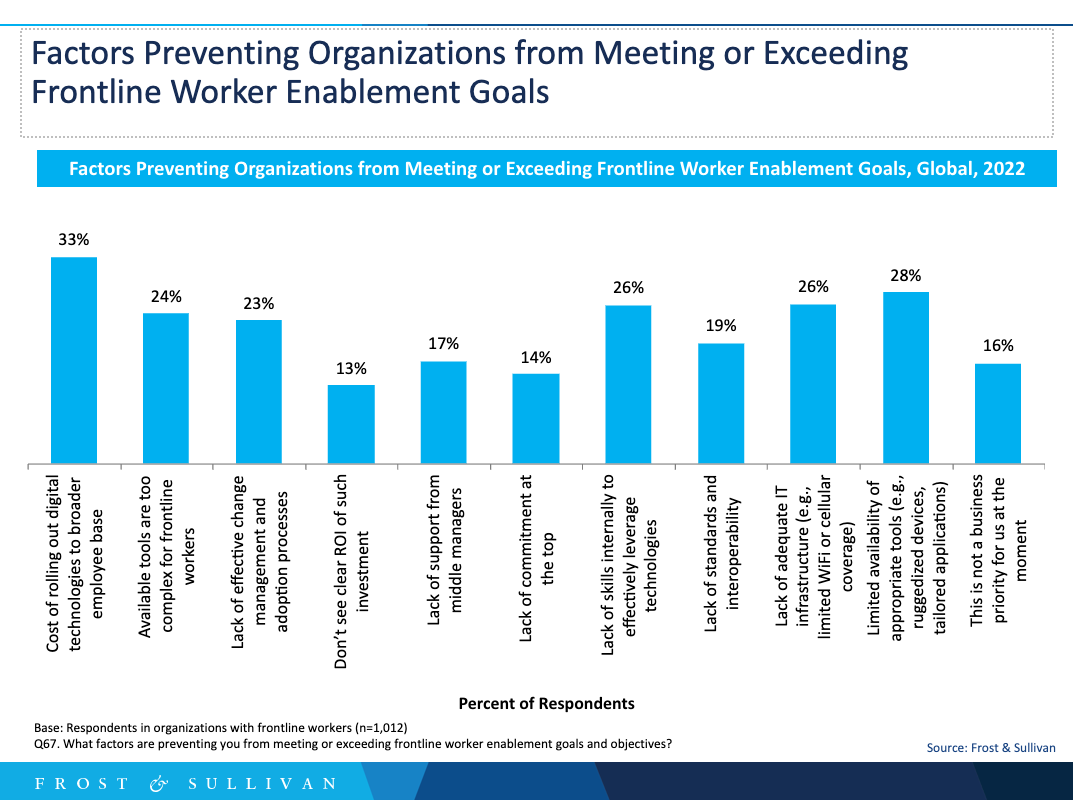As the unified communications-as-a-service (UCaaS) market matures and fewer on-premises deployments are available to convert to cloud solutions, competition rapidly intensifies, and providers eagerly seek to encroach on each other’s installed bases. Also, due to varying provider strategies and ability to execute effectively the growth rate and market share gap between the winners and laggards among UCaaS providers is widening. To thrive and outperform competitors, market participants must accelerate innovation, offer differentiated value propositions and quickly identify new growth opportunities.
Frost & Sullivan believes a critical growth and differentiation opportunity for UCaaS providers can be found in vertical excellence and equipping frontline workers. Communications technology developers and service providers have traditionally paid little more than lip service to the notion of vertical strategies. With most of their attention focused on office workers as the heavy users of communications tools, UCaaS providers have failed to provide differentiated value in different verticals and, in particular, to frontline workers. Effective digital transformation and workflow optimization in different industries will require equipping frontline workers with appropriate communications and collaboration tools. Technology advancements (e.g., 5G, flexible application programming interfaces (APIs), and programmability) are enabling innovative service providers to differentiate from competitors with vertical strategies and tap into new user segments, including frontline workers.
To empower frontline workers, technology developers and service providers must possess certain expertise and skill sets, as follows:
- Deep understanding of key industry challenges, trends and workflows is critical for providers to develop and effectively pitch appropriate communications and collaboration solutions to frontliners in each vertical.
- Tailored solution functionality, packaging and pricing may be required to address unique user needs while keeping customer costs at bay.
- Broader solutions portfolios that enable one-stop shopping can provide value in certain verticals where advanced communications solutions may require connectivity or security upgrades.
- Dedicated vertical experts within provider organizations, as well as multi-party industry alliances can help communications providers develop strong value propositions for targeted verticals.
The API Economy Creates New Growth Opportunities for UCaaS Providers
The monolithic nature of legacy technologies prevented vendors from delivering tailored solutions to address unique user needs. Even first-generation IP-based UC solutions were difficult to customize and integrate with third-party solutions to more tangibly impact industry-specific workflows.
However, most modern UCaaS solutions have shed monolithic applications in favor of microservices and an open platform approach. Empowered with APIs, communication platforms as a service (CPaaS) and programmability, technology developers can now employ a tailored approach to each industry and more effectively serve the frontliners within customer organizations. Increased focus on frontline worker empowerment and workflow optimization is driving integration of communications within productivity, business, and vertical software and services. When integrated with vertical apps—inventory and property management systems, shift scheduling, safety alerts, etc.—communications and collaboration features can provide considerable value to frontline workers in hospitality, healthcare, retail, and other verticals. Communications-enabled IoT devices and equipment can help improve safety, gain efficiencies, reduce costs, and improve product quality in manufacturing, logistics, automotive, and other verticals. These integrated solutions will create opportunities to leverage data analytics on a much greater scale.
Evaluating the Frontline Worker Opportunity
Frontline workers are a key part of the workforce in the majority of organizations. Out of approximately two and a half billion non-desk/frontline workers around the world, an estimated one billion require tailored communications and collaboration tools to complete their job tasks.
There is no perfect definition of frontline workers. Generally, frontliners are employees within an organization who must be physically present at a business or customer location to perform their job duties. Other terms such as firstline or essential workers are also often used in reference to various occupations that share certain common characteristics, as follows:
- Directly interact with customers, clients or the general public
- Are at the end of a given production chain or customer journey
- Typically do not work in a “carpeted” office and do not have dedicated desks and/or knowledge-worker toolkits
- Are indoor or outdoor mobile (campus roamers, field force, retail- or manufacturing-floor worker)
- Work in environments that can present physical challenges related to weather conditions or exposure to certain hazardous materials, equipment and people
- Often perform essential job functions
- Require tailored IT and communications tools—ruggedized, hands-free, mobile devices; integration with vertical-specific systems, devices and services; etc., rather than the more generalized hardware and services utilized by office or knowledge workers
Not all frontline workers meet all criteria above; however, several characteristics typically are sufficient to differentiate frontline workers from desk-based (knowledge, information or task) workers.
Understanding Organizations’ Frontline Worker Enablement Priorities
Frost & Sullivan conducts frequent IT/telecom decision-maker (ITDM) surveys to gain insights on:
- Factors impacting technology investments to empower frontline workers
- Communications and collaboration solutions used by frontline workers
- Differences across vertical industries regarding communications and collaboration tool usage and investments
In our most recent surveys, more than one half of organizations in all verticals consider their frontline workers digitally well equipped. However, 74% in the high tech industry perceive their frontline workers to be digitally well equipped compared to only 51% in the energy, utilities & recycling sector. Technology adoption also varies across industries. Overall, most organizations have either adopted or plan to invest in a variety of communications and collaboration tools—including mobile/smartphones, enterprise telephony, cloud video meetings and team messaging—to equip their frontline workers. Future investment plans demonstrate organizations’ clear acknowledgement of the benefits of emerging technologies such as AI, mixed/augmented/virtual reality, software bots and biometric authentication methods.
Certainly, technology adoption varies by vertical. For example, more than one-fifth of healthcare organizations have not invested and do not plan to invest in software bots or mixed/augmented/virtual reality. Similarly, more than one-fifth of manufacturing and retail & wholesale firms have not invested and do not plan to invest in software bots, mixed/augmented/virtual reality, wearable devices or biometric authentication methods to equip their frontline workers.
When it comes to selecting communications solutions and providers, more organizations considered industry-specific knowledge, an end-to-end solutions portfolio and integrations with mission-critical workflows to be crucial or very important compared to tailored solutions, partnerships with vertical specialists or dedicated vertical experts within provider organizations. The lesser emphasis on highly specialized capabilities may imply that extensive technology or organizational adjustments may not be needed for technology providers to address frontline workers' needs.
It is important to note that a variety of factors prevent customer organizations from fully empowering their frontline workers with appropriate digital tools. The cost of rolling out digital technologies to the broader employee base stands out as the main factor preventing organizations from digitally equipping frontline employees.
Communications Provider Success Strategies
Few communications and collaboration solution providers have launched well-defined frontline worker strategies. However, several leading market participants--including 8x8, Atos, Avaya, Cisco, GoTo, Intermedia, Microsoft, Mitel, RingCentral, Theatro, Wildix, and Zoom and certain telecom operators such as AT&T, CBTS, Lumen, Spectrum Enterprise, Verizon, Vodafone and Windstream—are at different stages of articulating a vision and developing solutions for different vertical markets. In most instances, frontline worker needs are an important part, but rarely at the center of communications providers’ vertical value propositions. Going forward, vendors and technology developers that succeed in developing robust vertical strategies, particularly strategies that include an articulated approach to frontliners, will differentiate from competitors and deliver greater customer value.
To differentiate, providers must gain deep understanding of business processes within different verticals and identify specific job functions to target as potential use cases for embedded and/or integrated communications features. They must seek to entrench themselves as the embedded communications functionality in popular third-party software to capitalize on this opportunity. Providers must also leverage integrated, extensible platforms to enable unique persona-based user experience—e.g., field service—that combine UC and contact center features. Through APIs and SDKs, providers can enable enterprise and third-party developers to embed their communications functionality into a website, business application, desktop client, or mobile app. As the library of applications and integrations grows, the next logical step for providers would be to offer a marketplace that allows bi-directional exchange of
information within an ecosystem of applications through an extensive set of APIs. Finally, a suite of analytics tools that combine workflow/business app data with communications stats can provide businesses with deeper insights into issues (e.g., productivity bottlenecks, business process disruptions) and also enable decision makers to use predictive analyses to re-design processes and improve key performance metrics.
More information on this topic is available in Frost & Sullivan’s study: Empowering Frontline Workers to Drive Business Transformation












